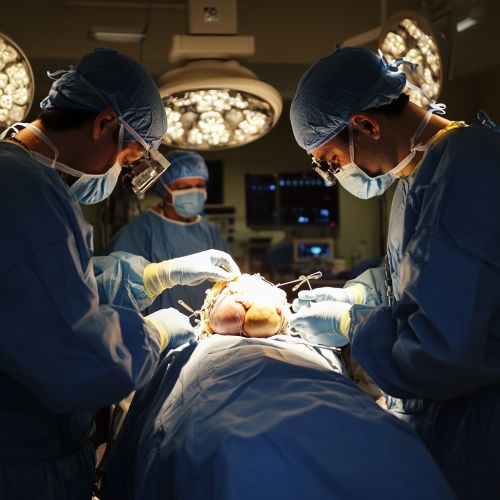Graft rejection
Introduction
Graft rejection is a complex immunological process wherein a recipient's immune system recognizes and attacks a transplanted organ or tissue, leading to the failure of the graft. This phenomenon is a significant challenge in the field of transplantation medicine and necessitates a comprehensive understanding of immunology, histocompatibility, and the mechanisms of immune response.
Types of Graft Rejection
Graft rejection can be broadly categorized into three types: hyperacute, acute, and chronic rejection. Each type is characterized by distinct immunological mechanisms and clinical presentations.
Hyperacute Rejection
Hyperacute rejection occurs within minutes to hours after transplantation and is primarily mediated by pre-existing antibodies in the recipient's blood. These antibodies recognize antigens on the donor graft, leading to the rapid activation of the complement system and subsequent destruction of the graft. This type of rejection is often seen in cases where there is a significant mismatch in ABO blood groups or HLA antigens.
Acute Rejection
Acute rejection typically occurs within days to weeks post-transplantation and involves both cellular and humoral immune responses. T cells play a crucial role in this process by recognizing foreign antigens presented by the donor's MHC molecules. This recognition leads to the activation of cytotoxic T cells, which directly attack the graft, and helper T cells, which stimulate B cells to produce antibodies against the graft.
Chronic Rejection
Chronic rejection is a long-term process that can occur months to years after transplantation. It is characterized by progressive fibrosis and vascular changes in the graft, leading to its eventual failure. The exact mechanisms underlying chronic rejection are not fully understood, but it is believed to involve a combination of immune-mediated injury and non-immune factors such as ischemia and reperfusion injury.
Mechanisms of Immune Response
The immune response to a transplanted graft involves a complex interplay of innate and adaptive immune mechanisms.
Innate Immune Response
The innate immune response is the first line of defense and involves the activation of macrophages, dendritic cells, and NK cells. These cells recognize pathogen-associated molecular patterns (PAMPs) and damage-associated molecular patterns (DAMPs) on the graft, leading to the release of pro-inflammatory cytokines and chemokines.
Adaptive Immune Response
The adaptive immune response is more specific and involves the activation of T and B lymphocytes. T cells recognize foreign antigens presented by APCs through the T cell receptor (TCR). This recognition leads to the clonal expansion of T cells and the differentiation into effector cells. B cells, on the other hand, produce antibodies that target specific antigens on the graft.
Histocompatibility
Histocompatibility refers to the degree of antigenic similarity between the donor and recipient. The primary histocompatibility antigens are the HLA molecules, which are highly polymorphic and play a crucial role in the immune response to transplanted tissues. Matching HLA antigens between donor and recipient can significantly reduce the risk of graft rejection.
Immunosuppressive Therapy
To prevent graft rejection, recipients are typically placed on immunosuppressive therapy. These medications work by inhibiting various components of the immune response.
Calcineurin Inhibitors
Calcineurin inhibitors, such as Cyclosporine and Tacrolimus, inhibit T cell activation by blocking the production of interleukin-2 (IL-2).
Antiproliferative Agents
Antiproliferative agents, such as Mycophenolate mofetil and Azathioprine, inhibit the proliferation of T and B cells.
Corticosteroids
Corticosteroids, such as Prednisone, reduce inflammation and suppress the immune response by inhibiting the production of pro-inflammatory cytokines.
Monoclonal Antibodies
Monoclonal antibodies, such as Basiliximab and Rituximab, target specific components of the immune system to prevent rejection.


Diagnosis of Graft Rejection
The diagnosis of graft rejection involves a combination of clinical, laboratory, and histopathological assessments.
Clinical Assessment
Clinical assessment includes monitoring for signs and symptoms of graft dysfunction, such as decreased organ function, pain, and swelling.
Laboratory Tests
Laboratory tests include measuring levels of serum creatinine, liver enzymes, and other biomarkers indicative of graft function.
Histopathological Examination
Histopathological examination of biopsy samples from the graft can reveal characteristic features of rejection, such as lymphocytic infiltration, endothelial damage, and fibrosis.
Prevention and Management
Preventing and managing graft rejection involves a combination of pre-transplant screening, immunosuppressive therapy, and regular monitoring.
Pre-Transplant Screening
Pre-transplant screening includes HLA typing, crossmatching, and assessing the recipient's immunological risk factors.
Immunosuppressive Therapy
As mentioned earlier, immunosuppressive therapy is crucial in preventing rejection. The choice of regimen depends on the type of transplant, the recipient's risk factors, and the presence of any comorbid conditions.
Regular Monitoring
Regular monitoring involves frequent clinical assessments, laboratory tests, and biopsies to detect early signs of rejection and adjust the immunosuppressive regimen accordingly.
Future Directions
Research in the field of transplantation is ongoing, with a focus on improving graft survival and reducing the side effects of immunosuppressive therapy.
Tolerance Induction
One promising area of research is tolerance induction, which aims to achieve long-term graft acceptance without the need for lifelong immunosuppression. This can be achieved through various strategies, such as mixed chimerism and regulatory T cell therapy.
Biomarkers
The identification of novel biomarkers for early detection of rejection and monitoring of immunosuppressive therapy is another area of active research.
Gene Editing
Gene editing technologies, such as CRISPR-Cas9, hold potential for modifying donor organs to reduce their immunogenicity and improve compatibility with the recipient.
